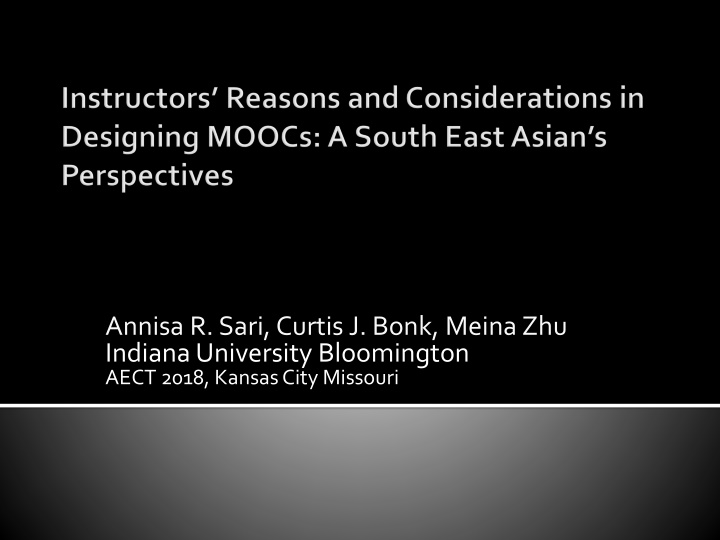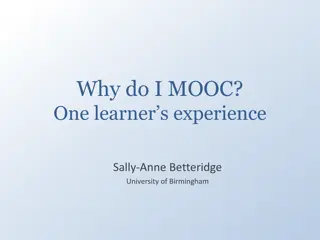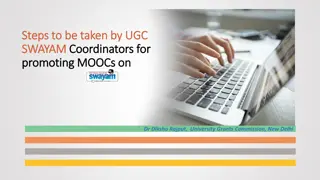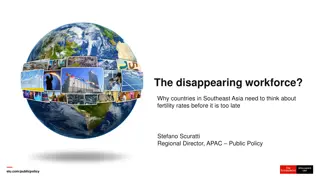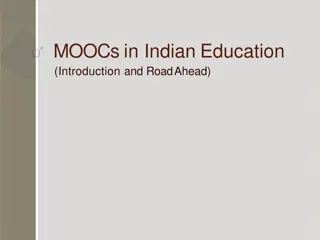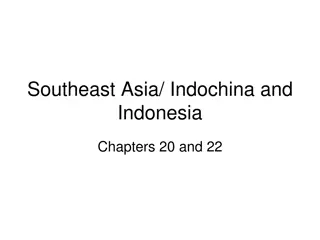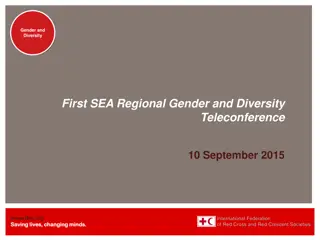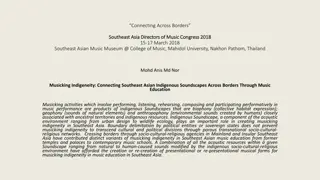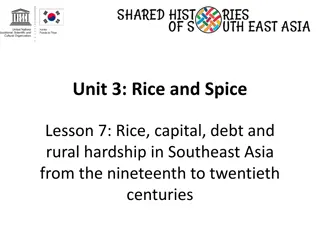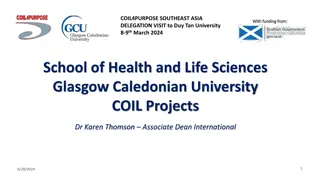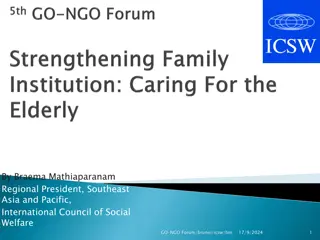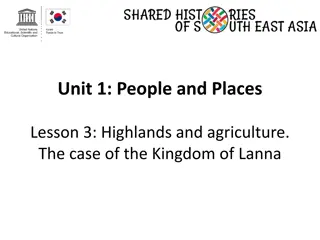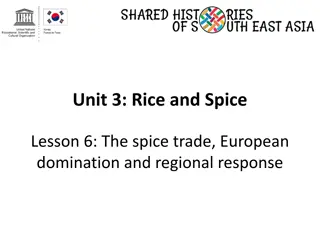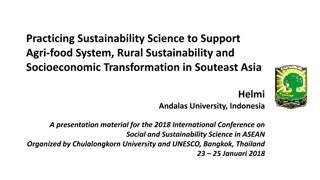Examination of MOOCs in Southeast Asia: Trends and Considerations
Exploration of MOOCs in Southeast Asia, focusing on research findings regarding MOOC design, expansion in countries like Indonesia and Malaysia, instructor motivations, and key factors in MOOC design. The study utilizes a mixed-method approach with survey data and interviews from participants in the region.
Download Presentation

Please find below an Image/Link to download the presentation.
The content on the website is provided AS IS for your information and personal use only. It may not be sold, licensed, or shared on other websites without obtaining consent from the author.If you encounter any issues during the download, it is possible that the publisher has removed the file from their server.
You are allowed to download the files provided on this website for personal or commercial use, subject to the condition that they are used lawfully. All files are the property of their respective owners.
The content on the website is provided AS IS for your information and personal use only. It may not be sold, licensed, or shared on other websites without obtaining consent from the author.
E N D
Presentation Transcript
Annisa R. Sari, Curtis J. Bonk, Meina Zhu Indiana University Bloomington AECT 2018, Kansas City Missouri
Debate & critiques around MOOCs MOOC course design is an essential factor and pre-requisite potential to effective learning experience (Margaryan, Bianco, & Littlejohn, 2015). The study of MOOCs research articles published between 2014 and 2016 showed that instructor- focused research is the least studied area after student-focused, design-focused, and context and impact focused (Zhu, Sari, & Lee, 2018)
The expansion of MOOCs in southeast Asia: Indonesia, Malaysia, Singapore, Thailand, and the Philippines have begun to launch MOOCs, but the MOOCs in Indonesia and Malaysia are part of key strategic government initiatives (Abas, 2015, p. 233).
MOOCs have been characterized as an online course which is open to anyone who has internet access, based on self-motivated learning, and can be accessed anytime and anywhere (Israel, 2015). The openness = no specific requirements regarding academic qualification, fees, and course completion (McAuleyet al., 2010). The massiveness = the large number of students, without creating extensive disruption on component parts or activities of the course (Anderson, 2013) .
1. What are the instructors reasons to offer MOOC? 2. What factors do instructors consider in designing their MOOC?
Research Design: mixed method design (Creswell, 1999) Data Collection: Survey, interview Participants: 46 survey participants (15.6%) and 9 interviewees
Interviewees demographic information Number Countries Providers 1 Malaysia OpenLearning 2 Malaysia OpenLearning 3 Malaysia OpenLearning 4 Indonesia Akademi CIPS 5 Indonesia iMOOC 6 Indonesia iMOOC 7 Indonesia iMOOC 8 Indonesia MOOCs UniversitasTerbuka 9 Indonesia IndonesiaX
RQ Data Sources Data Analysis RQ1 Survey multiple-choice questions Descriptive Statistics Interview (Knupfer& McLellan, 1996) Content analysis (Vaismoradi, Turunen, & Bondas, 2013) RQ2 Survey multiple-choice questions Descriptive Statistics Interview Content analysis
MOOC Providers 24 8 5 5 3 1 Akademi CIPS FOCUS Fisipol UGM iMOOC MOOCs Universitas Terbuka IndonesiaX Open Learning
Primary Discipline Affiliation Education 10 Social Sciences 9 Mathematics, Statistics, and 6 Business and Management 4 Engineering and Architecture 4 Health Sciences 4 Other 4 Humanities 2 Law 2 Agriculture 1 Natural Sciences 0
The Number of Participants 36 9 1 0 0 0
The number of MOOCs have been designed 33 9 4 1 2 3 or more
The Delivery Format of MOOC Hybrid or blended type of MOOC 23 Instructor led with instructor assistants, and/or tutor support 10 Instructor led with no additional teaching support 5 Self-paced 4 Other (Please describe): 2 Primarily learner/participant driven 2
Reasons to Offer MOOCs Increase participant access to education 32 Contributing to human development 26 Institutional encouragement 26 To experience teaching and 24 Personal interest 15 For research purposes 7 Other (Please describe): 1
Two intervieweesstated that their courses were part of contribution to human development: Itwas designed for elevating awareness of the ASEAN COMMUNITY. The (English) program is designed to meet the needs of Indonesian educators, the design and content of the program is made to strongly relate to the Indonesian education context and able to be practiced in a real life setting.
During the interview, at least two interviewees explained that they were appointed by their institution to offer MOOCs. Actually my course has been selected by the university to be offered in MOOC, and the university asked me to develop the content of this course for MOOC.
Design Considerations Easy access to the learning materials 43 Learning objectives 41 Available online resources (e.g., OER, 40 Pedagogical approaches 39 Technical support 37 MOOC platform 37 Time needed to design MOOC 36 The ideal course structure 36 Software supports 36 Participant interaction 36
Other considerations: Institutional support, possible context application (local/national/international), culture and language, assessment method, tools for communication, hardware supports, course duration, and participant characteristics
One interviewee mentioned the ideal course structure and participant characteristics: Variability of the audience, hence material should be general;and the length of duration, hence material should not exceed 7 minutes per session.
One interviewee considered participant interaction: Students active learning, at which students can shares their experiences & knowledge.
One interviewee explained the ideal course structure, learning objective, and assessment: The main consideration for designing our MOOC is the inter-connectedness between four elements.First the contents of each module, second the learning goals, third the ways of evaluating participants learning results, and fourth the timing or duration of each module.
There are 5 primary reasons for offering MOOCs: (1) personal interest (Hew & Cheung, 2014) (2) research purposes (Fadzil et al., 2015; Teplechuk, 2013) (3) experience teaching a large online course (Hew & Cheung, 2014) (4) institutional encouragement (Teplechuk, 2013) (5) altruism (Wong, 2016).
MOOCs design considered inter-connected factors Content, pedagogy, and supports are among the main factors of MOOC design consideration (ideal vs reality) Cross-cultural needs application context, culture and language, and participant characteristics (Mercado, Parboteeah, & Zhao,2004)
TheMOOC course design strategiesis approached from the perspectives of instructors. Expand these findings by adding more perspectives (e.g., students, affiliated institutions, or MOOC providers). This study only focuses on MOOCs developed by Indonesian and Malaysian instructors. An opportunity to extend the study to a bigger context (e.g., SEAsia, Asia, or world community).
Abas, Z. W. (2015). The glocalization of MOOCs in southeast Asia. Bonk, Lee, Reeves, & Reynolds (Ed.), MOOCs and open education: Around the world, 232-242. Anderson, Terry. (2013). Promise and/or peril: MOOCs and open and distance education. Retrieved on April 26, 2017 from http://www.col.org/SiteCollectionDocuments/MOOCsPromisePeril_Anderson.pdf Creswell, J. W. (1999). Mixed-method research: Introduction and application. Handbook of educational policy, 455-472. Fadzil, M., Latif, L. A., & Munira, T. A. M. (2015). MOOCs in Malaysia: A preliminary case study. MOOCs in Malaysia: a preliminary case study. Retrieved from: http://library.oum.edu.my/repository/1022/1/library-document-1022.pdf Hew, K. F., & Cheung, W. S. (2014). Students and instructors use of massive open online courses (MOOCs): Motivations and challenges.Educational Research Review,12, 45-58. Israel, M. J. (2015). Effectiveness of Integrating MOOCs in Traditional Classrooms for Undergraduate Students. International Review of Research in Open and Distributed Learning, 16(5), 102 118. Retrieved from? McAuley, A., Stewart, B., Siemens, G., & Cormier, D. (2010). The MOOC model for digital practice. Retrieved from http://www.elearnspace.org/Articles/MOOC_Final.pdf Mercado, S., Parboteeah, K. P., & Zhao, Y. (2004). On line course design and delivery: cross national considerations. Strategic Change,13(4), 183-192. Teplechuk, E. (2013). Emergent models of massive open online courses: an exploration of sustainable practices for MOOC institutions in the context of the launch of MOOCs at the University of Edinburgh. MBA dissertation, University of Edinburgh. Wong, B. T. (2016). Factors leading to effective teaching of MOOCs. Asian Association of Open Universities Journal, 11(1), 105- 118. Zhu, M., Sari, A. & Lee, M. M. (2018).A Systematic Review of Research Methods and Topics of the Empirical MOOC Literature (2014-2016). The Internet and Higher Education.
Questions and Comments? Annisa R. Sari Annisa R. Sari Curtis J. Bonk Curtis J. Bonk Meina Zhu Meina Zhu annsari@iu.edu annsari@iu.edu cjbonk@indiana.edu cjbonk@indiana.edu meinzhu@iu.edu meinzhu@iu.edu
